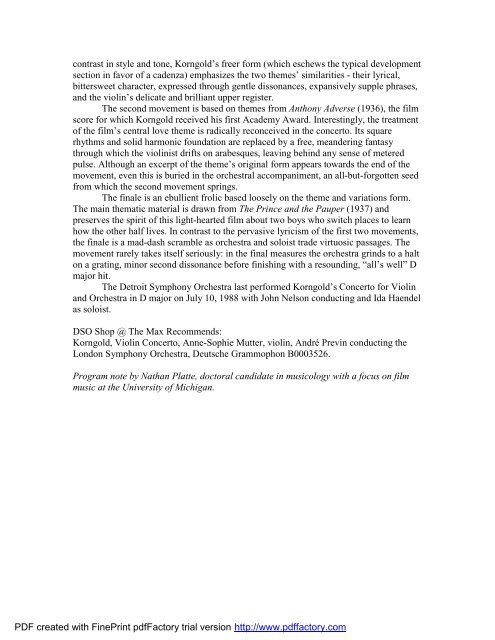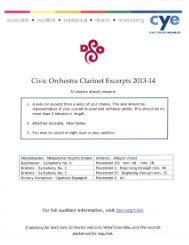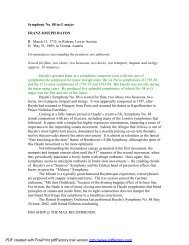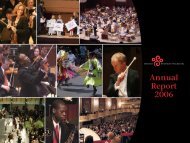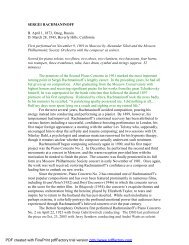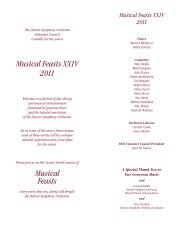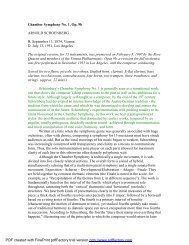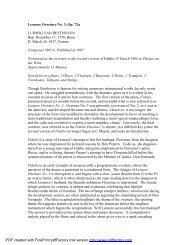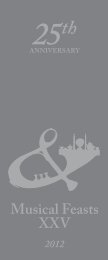Concerto for Violin and Orchestra in D major, Op. 35 ERICH ...
Concerto for Violin and Orchestra in D major, Op. 35 ERICH ...
Concerto for Violin and Orchestra in D major, Op. 35 ERICH ...
You also want an ePaper? Increase the reach of your titles
YUMPU automatically turns print PDFs into web optimized ePapers that Google loves.
contrast <strong>in</strong> style <strong>and</strong> tone, Korngold’s freer <strong>for</strong>m (which eschews the typical development<br />
section <strong>in</strong> favor of a cadenza) emphasizes the two themes’ similarities - their lyrical,<br />
bittersweet character, expressed through gentle dissonances, expansively supple phrases,<br />
<strong>and</strong> the viol<strong>in</strong>’s delicate <strong>and</strong> brilliant upper register.<br />
The second movement is based on themes from Anthony Adverse (1936), the film<br />
score <strong>for</strong> which Korngold received his first Academy Award. Interest<strong>in</strong>gly, the treatment<br />
of the film’s central love theme is radically reconceived <strong>in</strong> the concerto. Its square<br />
rhythms <strong>and</strong> solid harmonic foundation are replaced by a free, me<strong>and</strong>er<strong>in</strong>g fantasy<br />
through which the viol<strong>in</strong>ist drifts on arabesques, leav<strong>in</strong>g beh<strong>in</strong>d any sense of metered<br />
pulse. Although an excerpt of the theme’s orig<strong>in</strong>al <strong>for</strong>m appears towards the end of the<br />
movement, even this is buried <strong>in</strong> the orchestral accompaniment, an all-but-<strong>for</strong>gotten seed<br />
from which the second movement spr<strong>in</strong>gs.<br />
The f<strong>in</strong>ale is an ebullient frolic based loosely on the theme <strong>and</strong> variations <strong>for</strong>m.<br />
The ma<strong>in</strong> thematic material is drawn from The Pr<strong>in</strong>ce <strong>and</strong> the Pauper (1937) <strong>and</strong><br />
preserves the spirit of this light-hearted film about two boys who switch places to learn<br />
how the other half lives. In contrast to the pervasive lyricism of the first two movements,<br />
the f<strong>in</strong>ale is a mad-dash scramble as orchestra <strong>and</strong> soloist trade virtuosic passages. The<br />
movement rarely takes itself seriously: <strong>in</strong> the f<strong>in</strong>al measures the orchestra gr<strong>in</strong>ds to a halt<br />
on a grat<strong>in</strong>g, m<strong>in</strong>or second dissonance be<strong>for</strong>e f<strong>in</strong>ish<strong>in</strong>g with a resound<strong>in</strong>g, “all’s well” D<br />
<strong>major</strong> hit.<br />
The Detroit Symphony <strong>Orchestra</strong> last per<strong>for</strong>med Korngold’s <strong>Concerto</strong> <strong>for</strong> <strong>Viol<strong>in</strong></strong><br />
<strong>and</strong> <strong>Orchestra</strong> <strong>in</strong> D <strong>major</strong> on July 10, 1988 with John Nelson conduct<strong>in</strong>g <strong>and</strong> Ida Haendel<br />
as soloist.<br />
DSO Shop @ The Max Recommends:<br />
Korngold, <strong>Viol<strong>in</strong></strong> <strong>Concerto</strong>, Anne-Sophie Mutter, viol<strong>in</strong>, André Prev<strong>in</strong> conduct<strong>in</strong>g the<br />
London Symphony <strong>Orchestra</strong>, Deutsche Grammophon B000<strong>35</strong>26.<br />
Program note by Nathan Platte, doctoral c<strong>and</strong>idate <strong>in</strong> musicology with a focus on film<br />
music at the University of Michigan.<br />
PDF created with F<strong>in</strong>ePr<strong>in</strong>t pdfFactory trial version http://www.pdffactory.com


